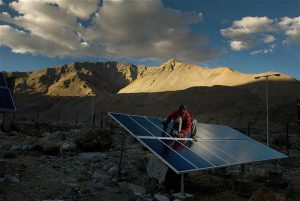The European Union has demanded that the United States and China stand behind a recent pledge to act jointly on climate change, by signing a legally binding protocol at a summit in Paris at the end of this year.
The EU’s executive, the European Commission, for the first time made it clear that it prefers a protocol, to be agreed in Paris, with legally binding emissions targets, in the mold of the previous Kyoto Protocol.
While the EU’s goals for a “Paris Protocol”, as it called a potential new agreement, were generally quite ambitious, the EU’s own pledge on emissions cuts of 40% by 2030 (from 1990 levels) fell rather short.
The bloc could try harder. The Commission calculated last year that even with no additional action, greenhouse gas emissions would still drop by a third (32.4%) by 2030.
Furthermore, the EU has a track record of surpassing its emissions targets. The European Environment Agency estimated last October that the EU’s greenhouse gas emissions in 2013 were already 19% below 1990 levels, all but reaching the target it has set to cut emissions by 20% by 2020, seven years early.
The EU’s 2030 target is disappointing, given that the EU is the first party to publish detailed plans for climate action under a new agreement, and so will set the tone for others.
Ratcheting up of targets
The pledge is also important because the EU – although it now only accounts for a tenth of global emissions – has traditionally been a leader on climate change, which has helped to smooth tensions between developed and developing countries.
It is very unlikely that the EU and other countries will revise their pledges. That is because of the effort involved in drafting and agreeing the contribution, which is expected to be submitted to the UN in the coming weeks.
All this reinforces why it would be better that a new agreement be focused on climate action to 2025, rather than 2030, thus giving countries an earlier opportunity to review and increase their ambition.
The US has made an offer for climate action in 2025, and it is unclear how the EU would amend its pledge if such a timeline were agreed in Paris, and whether that would open the door for greater ambition in subsequent years.
Kyoto Protocol
The EU’s proposal that a new agreement should have the same legal force as Kyoto appears something of a gamble. Unlike a voluntary agreement, a protocol with legally binding emissions targets would have to be ratified by national parliaments, presenting a significant hurdle in the US, in particular.
The EU is hoping that new cooperation between the US and China will help push a new, more ambitious deal over the line.
“The EU, China and the U.S. should send a particularly important signal of political leadership, setting the pace by joining the Protocol as early as possible,” it said.
The comparison with Kyoto is sure to please many developing countries, and in particular those more vulnerable to climate change, such as island states and African nations. That is because Kyoto was a detailed, rule-based and legally binding agreement, which is more likely to hold countries to their commitments.
The EU said that making emissions targets binding under international law would make a new agreement stronger, more durable and more predictable.
It also called for countries in Paris to agree for the first time a global emissions goal to guide successive, new rounds of emissions targets and a cycle of new targets every five years through to 2050. In this way, a Paris Protocol would effectively launch an open-ended diplomacy, making it potentially the most significant climate agreement of the century.
The proposal for 5-year review cycles is likely to feature in a final Paris agreement, given that it has broad support, both from developing countries and the US.
Countries in the past have failed to agree a global long-term emissions goal, which in turn has let them off the hook by failing to hold them collectively to account.
Longer-term goal
However, the EU’s proposed long-term goal was to cut emissions by 60% by 2050, compared with 2010 levels. That falls short of a goal for net zero emissions in the second half of the century, as demanded by some environmental groups.
Some aspects of the EC’s contribution differ from previous EU offers, for example what it commited to under Kyoto. This time the EU will meet its target domestically, with no option to offset its emissions by buying carbon credits from overseas. That means that a once multi-billion-dollar international carbon market remains on ice. And the EU did not offer to increase its ambition even in the event of a particularly successful summit in Paris.
The contribution published on February 25 was light on detail about renewable energy, for example.
Key strands of the EU’s contribution are unresolved, for example how to account for Europe’s forests. Trees absorb the greenhouse gas carbon dioxide as they grow, and so can effectively offset the effect of carbon emissions from power plants and factories.
However, EU officials assured me this week that there was no question that the bloc would use its forestry sector to offset emissions in this way. The 40% target would stand, and any net emissions reductions from the land use sector would therefore be in addition to this headline target.
And if Europe’s forests shrank, for whatever reason, leading to net emissions, then the rest of the economy would have to make up for that, leading to effort greater than 40% cut.
These are the rules that the EU has previously agreed on forests and land use, and has re-iterated there is no question of back-sliding on this commitment.
Post-2020 adaptation finance remains on ice
The EU did not offer this week any new finance to help poorer and more vulnerable countries cut emissions and prepare for climate change, under its pledge, saying that any such move remains premature.
That is sure to rile developing countries that have long argued that developed countries have so far failed to deliver on past promises to transfer funds and share technologies which would help them in cut emissions and adapt to climate change.
With UN climate talks set to resume in Bonn in just over three months’ time, we will soon see whether climate contributions will help, or hinder progress on the road to Paris.








